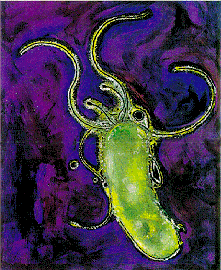How Does it Do it?
While Helicobacter pylori is catalase, oxidase, and urease positive, it is the urease that is key in allowing it to colonize inside of your acidic stomach! The enzyme urease breaks the urea in your stomach into ammonia (NH4+) and carbon dioxide (CO2). The production of ammonia is how this bacterium neutralizes the acidity of the stomach acid in its internal and surrounding environment.
Helicobacter
pylori releases urease to buffer its internal and
surrounding environment.
Once H. pylori is ingested, it enters the stomach lumen, or cavity. To get to the mucous layer where it colonizes, H. pylori is equipped with 4-6 flagella, making it a really good swimmer! Because it is a good swimmer, Helicobacter pylori can resist the muscular contractions of the stomach that push its contents further down the digestive tract. Each of these flagella end with a distinct bulb (boxed in red in the above picture), though it is not clear why. After arriving at the mucous layer, the bacterium then bores in to this layer utilizing its flagella and helical shape to create screw-like movements. This is quite an amazing feat, as the mucous layer is usually relatively impermeable because its job is to protect the epithelial cells beneath it and it.
Helicobacter pylori does not actually invade the epithelial cells of the stomach, but it can cause it to become inflamed by producing a toxin called vacuolating cytotoxin A. This toxin can invade the cell in a vacuole, which is a membrane bound cavity within the cell, causing severe gastritis and ulcers (O'Conor et al. 2003).
At some point in the bacterium's life cycle, some of the organisms change shape from a spiral bacilli to a coccoid form. The reasoning behind this is also unclear to whether it is an attempt to adapt to a stressful situation, a dormant stage, or a signal of death of the cell (American Water Works Association 2006).

To find out how Helicobacter pylori obtains its nutrients, click here.
